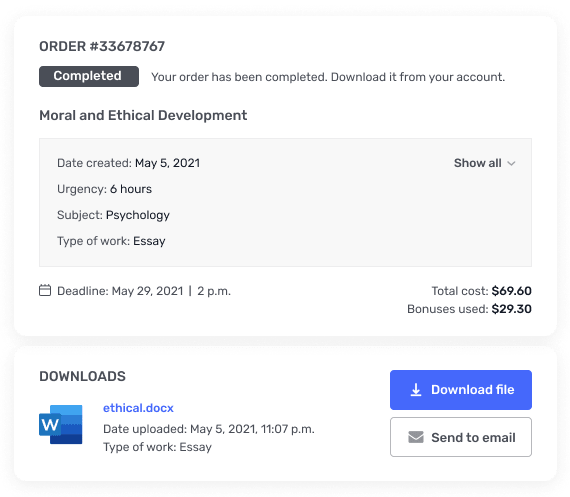Online Exam
Part 1 of 2 – Lesson 4 Questions 42.5/ 50.0 Points
Question 1 of 40
0.0/ 2.5 Points
Career management refers to the __________.
A. lifelong series
of activities that contributes to a person’s career exploration, establishment,
success, and fulfillment
B. process for
enabling employees to better understand and develop their career skills and
interests and to use these skills and interests most effectively within the
company and afterwards
C. process of using
activities like training and appraisal to provide a career focus
D. occupational
positions a person has over his or her lifetime
Question 2 of 40
2.5/ 2.5 Points
Which of the following best captures the meaning of the term
glass ceiling?
A. structural, yet
subtle barriers in corporate environments that inhibit the rise of talented
women to positions of leadership
B. inadequate
networking opportunities that result because of a lack of an “old girl’s
network” to mirror that of men
C. unspoken
decisions by corporate leadership that women should not be encouraged to
advance beyond middle management levels
D. the lack of
desire among women to pursue jobs with extreme levels of responsibility and
authority
Question 3 of 40
2.5/ 2.5 Points
Which of the following is a criticism of the forced
distribution method?
A. It damages
morale.
B. It promotes
unfairly.
C. It promotes those
who play the game well.
D. None of the
above.
Question 4 of 40
2.5/ 2.5 Points
Which of the following could result in a legally
questionable appraisal process?
A. conducting a job
analysis to establish criteria and standards for successful performance
B. basing appraisals
on subjective supervisory observations
C. administering and
scoring appraisals in a standardized fashion
D. using clearly
defined job-performance dimensions
Question 5 of 40
2.5/ 2.5 Points
Performance appraisals may be conducted by __________.
A. the immediate
supervisor
B. peers
C. rating committees
D. all of the above
Question 6 of 40
2.5/ 2.5 Points
The process of evaluating an employee’s current and/or past
performance relative to his or her performance standards is called __________.
A. recruitment
B. employee
selection
C. performance
appraisal
D. organizational
development
Question 7 of 40
2.5/ 2.5 Points
Who is in the best position to observe and evaluate an
employee’s performance for the purposes of a performance appraisal?
A. peers
B. rating committees
C. top management
D. immediate
supervisor
Question 8 of 40
2.5/ 2.5 Points
Behaviorally anchored rating scale (BARS. refers to an
appraisal method, which __________.
A. is based on
progress made toward the accomplishment of measurable goals
B. combines the
benefits of narratives, critical incidents, and quantified scales by assigning
scale points with specific examples of good or poor performance
C. requires that the
supervisor keep a log of positive and negative examples of a subordinate’s
work-related behavior
D. requires a
supervisor to evaluate performance by assigning predetermined percentages of
those being rated into performance categories
Question 9 of 40
2.5/ 2.5 Points
Peer appraisals have been shown to result in a(n.
__________.
A. reduction of
social loafing in the team
B. reduction of
group cohesion
C. decrease in
satisfaction with the group
D. tendency to
inaccurately predict who would be promoted
Question 10 of 40
2.5/ 2.5 Points
What process allows top management to diagnose the
management styles of supervisors, identify potential “people” problems, and
take corrective action with individual supervisors as necessary?
A. strategic
performance appraisal
B. organizational
development
C. upward feedback
D. critical
incidents
Question 11 of 40
2.5/ 2.5 Points
When goal setting, performance appraisal, and development
are consolidated into a single, common system designed to ensure that employee
performance supports a company’s strategy, it is called __________.
A. strategic
organizational development
B. performance
management
C. performance
appraisal
D. human resource
management
Question 12 of 40
2.5/ 2.5 Points
When different supervisors define levels of performance
(good, fair, poor. differently, unfair appraisals could result due to a problem
with __________.
A. unclear standards
B. halo effects
C. complexity
D. leniency
Question 13 of 40
2.5/ 2.5 Points
When a supervisor must criticize a subordinate in an
appraisal interview, it is best to __________.
A. hold the meeting
with other people who can diffuse the negative situation
B. provide examples
of critical incidents
C. acknowledge the
supervisor’s personal biases in the situation
D. provide feedback
once per year
Question 14 of 40
2.5/ 2.5 Points
When Amanda interviewed for a job with the employment
commission, the interviewer warned her that the job could be very stressful
with long hours and a lot of bureaucracy. The interviewer was trying to provide
__________.
A. reality shock
B. a realistic job
interview
C. disincentive
D. a challenge
Question 15 of 40
2.5/ 2.5 Points
When an employee’s personal characteristics such as gender
influence a supervisor’s evaluation of his or her performance, the problem of
__________ has occurred.
A. bias
B. stereotyping
C. central tendency
D. halo affect
Question 16 of 40
2.5/ 2.5 Points
Jason is generally considered unfriendly at work. His
supervisor rates him low on the trait “gets along well with others” but also
rates him lower on other traits unrelated to socialization at work. Jason’s
performance appraisal may be unfair due to __________.
A. impression
management
B. stereotyping
C. halo effects
D. strictness
Question 17 of 40
2.5/ 2.5 Points
Jackie is working with a coach to identify her personal
skills and interests. Then she plans to get information about opportunities
that fit her skills and interests and set career goals for what she seeks to
accomplish. Jackie is in the midst of __________.
A. organizational
development
B. career
development
C. career planning
D. training
Question 18 of 40
0.0/ 2.5 Points
Because in most organizations there is a hierarchy of goals,
employee performance standards should __________.
A. be standard
B. make sense in
terms of the broader organizational goals
C. be decided by the
top executive
D. all of the above
Question 19 of 40
0.0/ 2.5 Points
The __________ problem occurs when supervisors tend to rate
all of their subordinates consistently low.
A. central tendency
B. leniency
C. strictness
D. bias
Question 20 of 40
2.5/ 2.5 Points
Besides the supervisor, which of the following is available
to managers as an alternative source of performance appraisal information?
A. peers
B. rating committees
C. the employee
D. all of the above
Part 2 of 2 – Lesson 5 Questions 47.5/ 50.0 Points
Question 21 of 40
2.5/ 2.5 Points
Which of the following professions is considered “nonexempt”
from the provisions of the Fair Labor Standards Act?
A. attorney
B. physician
C. management
trainee
D. general manager
Question 22 of 40
2.5/ 2.5 Points
Which of the following is typically included in compensation
packages for a company’s top executives?
A. short-term and
long-term incentives
B. perks
C. executive
benefits
D. all of the above
Question 23 of 40
2.5/ 2.5 Points
__________ is a formal and systematic comparison of jobs to
determine the worth of one job relative to another.
A. Job analysis
B. Job evaluation
C. Benchmark
analysis
D. Job ranking
Question 24 of 40
2.5/ 2.5 Points
According to the Family and Medical Leave Act, eligible
employees can take unpaid, job-protected leave for the __________.
A. care of a child
B. birth of a child
C. care of a parent
D. all of the above
Question 25 of 40
2.5/ 2.5 Points
The __________ prohibits discriminating against employees
who are 40 years of age and older in all aspects of employment, including
compensation.
A. Fair Labor
Standards Act
B. Civil Rights Act
C. Equal Pay Act
D. Age
Discrimination in Employment Act
Question 26 of 40
2.5/ 2.5 Points
A __________ plan is an incentive plan that engages many or
all employees in a common effort to achieve a company’s productivity objectives
with any resulting cost-savings gains shared among employees and the company.
A. Scanlon
B. Lincoln incentive
C. Gainsharing
D. ESOP
Question 27 of 40
2.5/ 2.5 Points
Factors that establish how the jobs compare to one another
and set the pay for each job are called __________ factors.
A. compensable
B. job evaluation
C. ranking
D. analysis
Question 28 of 40
2.5/ 2.5 Points
A company using competency-based pay compensates for all of
the following except an employee’s __________.
A. range of skills
B. job title
C. depth of
knowledge
D. type of skills
Question 29 of 40
2.5/ 2.5 Points
External equity refers to __________.
A. how a job’s pay
rate in one company compares the job’s pay rate in other companies
B. how fair the
job’s pay rate is when compared to other jobs within the same company
C. the fairness of
an individual’s pay as compared with what his or her coworkers are earning for
the same or very similar jobs within the company, based on each individual’s
performance
D. the perceived
fairness of the processes and procedures used to make decisions regarding the
allocation of pay
Question 30 of 40
2.5/ 2.5 Points
The __________ states that employees of one sex may not be
paid wages at a rate lower than that paid to employees of the opposite sex for
doing roughly equivalent work.
A. American
Disabilities Act
B. Civil Rights Act
C. Employer
Retirement Income Security Act
D. Equal Pay Act
Question 31 of 40
0.0/ 2.5 Points
Jack is a sales manager who recently learned that human
resource managers with similar responsibilities and spans of control earn more
than he does. Jack is concerned with the __________ form of equity.
A. external
B. internal
C. distributive
D. individual
Question 32 of 40
2.5/ 2.5 Points
__________ is any salary increase the firm awards to an
individual employee based on his or her individual performance.
A. Merit pay
B. Variable pay
C. Competency-based
pay
D. Piecework
Question 33 of 40
2.5/ 2.5 Points
A __________ is comprised of jobs of approximately equal
difficulty or importance as established by job evaluation.
A. pay group
B. benchmark
C. pay grade
D. class
Question 34 of 40
2.5/ 2.5 Points
According to the Family and Medical Leave Act, eligible
employees can take up to __________ weeks of unpaid, job-protected leave for
the birth of a child or for the care of a child, spouse, or parent.
A. two
B. four
C. six
D. 12
Question 35 of 40
2.5/ 2.5 Points
When using the job classification method of job evaluation,
raters categorize jobs into groups of similar jobs called __________.
A. classes
B. grades
C. sections
D. cohorts
Question 36 of 40
2.5/ 2.5 Points
Supplemental executive retirement plans and supplemental
life insurance are classified as __________ in executive compensation packages.
A. base pay
B. short-term
incentives
C. long-term
incentives
D. executive
benefits
Question 37 of 40
2.5/ 2.5 Points
Which of the following is categorized as an indirect payment
portion of employee compensation?
A. wages
B. salaries
C. employer-paid
insurance
D. bonuses
Question 38 of 40
2.5/ 2.5 Points
Which compensation-related law contains minimum wage,
maximum hours, overtime pay, equal pay, and child labor provisions?
A. Davis-Bacon Act
B. Fair Wages Act
C. Civil Rights Act
D. Fair Labor
Standards Act
Question 39 of 40
2.5/ 2.5 Points
What type of pay plan is being used when workers are paid a
sum for each unit they produce?
A. base pay
B. competency-based
pay
C. job-based pay
D. piecework
Question 40 of 40
2.5/ 2.5 Points
When using the job classification method of job evaluation,
raters categorize jobs into groups of jobs that are similar in difficulty but
not in context called __________.
A. classes
B. grades
C. sections
D. cohorts




